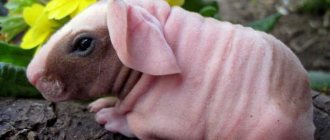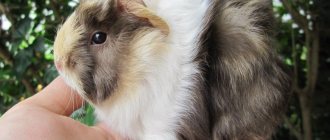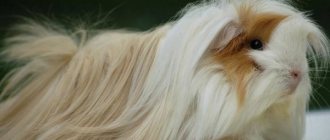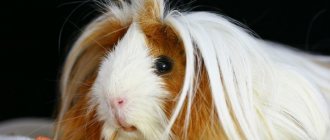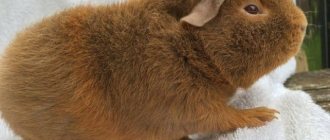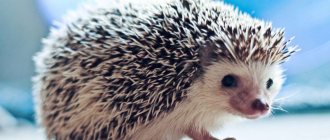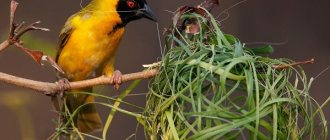- home
- Guinea pig
- Guinea pig breeds
02/16/2019 Many breeders choose for breeding the cutest and most unusual breeds of various animals, which are popular among lovers of beautiful pets. Guinea pigs are no exception; even among them there is a breed that is extremely popular despite its overall strange appearance. A hairless skinny or baldwin guinea pig is an ideal solution for those who suffer from allergic reactions or simply dream of a unique pet.
Story
It is noteworthy that many of us still have no idea about the etymology of the name “guinea pig” when it comes to a land rodent. In the nations of the world, this name has many variations, one way or another tied to the word “pig”, only the location changes, some call it Guinean, others Indian or Dutch. Depending on the country, the geographical location of the guinea pig also changes.
However, the real homeland of guinea pigs is South America. Since ancient times, people have tamed these animals, discovering their calmness in captivity.
These days we have many varieties and breeds of these cute rodents, whether they are incredibly fluffy long-haired specimens or hairless and defenseless Baldwins and Skinnies. The two breeds differ in their origins, while the Skinny was created through natural mutation in 1976, and the Baldwin did so a full 12 years later.
An interesting fact is that two hairless guinea pigs may well have offspring with hair, but the genes of a hairless guinea pig will already be embedded in the pedigree, which means that the next offspring will be able to contain such piglets.
At the beginning of breeding, the process of producing a large population of this breed took scientists a sufficient amount of time, precisely because not every litter was accompanied by hairless offspring. At first, the hairless little cubs were perceived as a dangerous gene mutation that could lead to illness and degeneration. The first recorded litter of this breed was completely destroyed, however, none of the breeders suspected that a similar gene existed in the parents.
The first hairless guinea pigs had very light skin tones and red eyes. Being albinos, they had a rather weak body, but over time, the bodies of their relatives became stronger and stronger.
Natural enemies of skinny
Photo: What skinny looks like
Skinnies have no natural enemies, as they are domestic animals. Skinnies are more vulnerable to elements and factors that cause their health to deteriorate. They are sensitive to low and high temperatures. They should be placed in a room with normal room temperature. Feeding skinnies properly and placing them in a moderate temperature room allows them to maintain a normal body temperature.
Because they lack hair, they are more vulnerable to injury, infection, and skin lacerations. Skinnies with exposed skin should be handled with care as they are extremely vulnerable to injury and infection. Therefore, as a necessary precaution, they should be stored indoors in a controlled environment. They should be introduced to sunlight, but from then on, their playful and curious nature must be monitored. They may end up causing injury to their delicate bodies.
Their most significant difference is that skinnies must be kept indoors. Due to their lack of fur, they have trouble maintaining body heat when they are in cooler environments. They also do not cope well with drafts. Skinny bedding should be soft and free of sharp objects and surfaces. They are truly sensitive and any minor vulnerability they encounter must be addressed to ensure their overall safety.
Breeds of hairless guinea pigs
We know that hairless guinea pigs have been bred into two breeds with slight differences. The main difference is the amount of fur remaining on the body and its location; not all animals are completely deprived of fur.
- Baldwin. There is no hair on the body of these animals, but they are born covered with light down.
- Skinnies demonstrate a completely opposite situation. Being born bald, later a light fluff may appear on the body on the paws and face.
One way or another, both breeds have a rather funny appearance, resembling either small tailless kittens or tiny hippos. In any case, these cute animals are liked by everyone without exception.
What do they eat
Skinnies are herbivores. They love hay with greens. Skinnies are coprotrophs; they feed on their own excrement.
It is necessary to add vitamin C to animal feed, since the animal’s body is not able to produce this vitamin on its own. You can purchase this vitamin in liquid form and add it to water or include green and red peppers in Skinny’s diet. But green peppers are more suitable for daily feeding, as they contain less sugar. Several times a week the pig is given 2 leaves of cabbage. Skinny should be given mint and broccoli once every 7 days.
To maintain the balance of vitamins in the mammal’s body, you should feed it cucumbers and tomatoes, apples and citrus fruits, as well as spinach and beans. Skinnies need phosphorus, so they should be given oats and barley a couple of times a week. Pregnant females should be pampered with nuts and seeds more often. But there are foods that are strictly contraindicated for mumps. These are potatoes, meat and chocolate, any fried foods and sweets.
The first time after birth, the young need mother's milk and, if the pig is rejected by the mother, it must be fed manually using a teaspoon. A syringe cannot be used, as the animal may choke. You can feed your pig with goat's milk or formula.
Hairless guinea pigs: history of the origin of breeds
The history of the origin of the two breeds has a fairly similar picture, however, they are separated by as many as twelve years.
Skinny Guinea Pig
Skinny guinea pigs have their origins in Montreal, Canada. It was there, in the early seventies, that breeders began to conduct research aimed at developing a rare breed of these animals, very different from their predecessors.
To the surprise of scientists, several hairless piglets were born, born from completely normal parents, with no differences in their genome from most individuals. Three females, impregnated by the same father, produced fragile and hairless offspring. The development of these cubs was slow, their health was weakened and they finally died out after a short period of time. However, ten years later, the experiment was repeated in an identical manner. In the future, scientists decide to keep the cubs for further breeding. It was then that the name for the breed that does not have hair was born. Literally “skinny” translates as “skin and bones.” It was in Canada that the story of the glory of this funny breed began.
Baldwin Guinea Pig
Ten years later, a similar breed of hairless guinea pigs originated in San Diego, California.
The development of the second breed was of the same random nature. Carol Miller, the breeder of these cute rodents, chose two individuals that had one of the most popular colors at the time - “Golden Solid”. At that time, the girl did not even suspect what an unusual outcome the breeding would end. The female gave birth to a litter of completely normal and cute cubs with characteristic fluff on their bodies. After several days, they suddenly began to shed the remnants of fur from their bodies, which clearly surprised the breeder. Ten days later, not a single hair remained on the body of all the piglets, which further increased her anxiety.
As in the first case, the appearance of such an unusual offspring caused the owner to think about the illness of her charges. Despite the fears, the health and development of the babies were no different from usual, and the veterinarian only confirmed their absolute normality.
The breeder decided to continue the experiment, crossing already grown individuals with each other. It was then that the story of one of the most unusual breeds of guinea pigs began. The name for the breed is derived from the English word "blad", meaning bald.
Appearance of naked guinea pigs
Despite the general similarities, these breeds have many differences that should be given special attention.
What does Skinny pig look like?
- A large body with well-developed muscles clearly contradicts the name of the breed, however, the length of the animal can reach thirty centimeters. The total weight of one individual is about one kilogram; naturally, the weight of males may slightly exceed the weight of females.
- Short paws with developed finger motor skills.
- A large head, rather large rounded ears are located on a short but powerful neck. The color range of the iris varies from dark brown to bright red. Eye color always depends on the color type of the animal.
- The skin color of this breed is truly extensive and varied. Black, white, beige and brown, all these colors can either completely cover the body or be scattered in spots. One individual may have two to three colors on its body.
- As already mentioned, the body of these guinea pigs is covered with imperceptible fluff, creating a velvety coating that is very pleasant to the touch. A denser coat can settle on the rodent's paws and head.
What does a Baldwin pig look like?
- The body of these animals is slightly smaller than their relatives, but has more graceful forms. The body is much smaller, does not reach more than twenty-five centimeters, and the weight does not exceed eight hundred grams.
- The muzzle of these animals is more curved, and their ears hang down in cute burdocks. The head itself is small in size, and the eyes of individuals are only black or red.
- The variety of colors is also unlimited, which makes choosing a Baldwin guinea pig really interesting.
Reproduction
There is no need to create special conditions for reproduction; everything is simple and easy. Females reach sexual maturity at the age of 2-2.5 months, males at 3 months. But here it is worth saying that at this age the body is not fully formed, it is quite weak, and the immune system is also not strengthened, so pregnancy at this age is not desirable, even dangerous. The optimal age at which mating is recommended is 6 months.
During pregnancy, vitamin E, B and others must be added to the diet to ensure the health of the mother and cubs. Nutrition should be correct and complete, but make sure there is no overfeeding. The duration of pregnancy is about 70 days.
During this time she needs separate housing. Try to protect her from stress as much as possible and touch her less. Handle only in extreme cases, do not squeeze, so as not to harm the fetus.
After giving birth, the female needs at least six months to fully recover, after which she can be bred again. At 6–8 months, the female is ready to continue the race. Males become sexually mature starting at three months. However, the optimal age for producing offspring is six months for females and 7 months for males.
Character and behavior of hairless animals
Like their hairy relatives, these guinea pigs have amazing intelligence and developed empathy for humans. Calm and measured, they never show aggression towards their owner. You don’t have to endure the animal’s hysterical behavior; they prefer to spend their leisure time napping or entertaining games.
Guinea pigs simply love long sleep and are ready to make friends with your other pets and share their daytime rest with them. A distinctive feature of this breed is its extreme affection for people. The owner should not leave his own for a long time, much less forget about him. These rodents always feel sad from loneliness and can fall into a state of stress that can cause harm to their health.
The hairless breed of guinea pigs has a vulnerable character and a sensitive psyche, so you should not keep them in a stressful environment. Daily screams and human cruelty can lead to the early death of an animal that is unable to withstand such stress on the nervous system.
In addition, these animals have an amazingly developed intelligence, allowing them not only to immediately remember their nickname, but also to communicate with their owner, rising up to him on their hind legs. With the help of rewards, you can train your pet, but you should not get too carried away and tire him out with complex tasks.
Feeding rules
So, as already mentioned, these animals need more food due to increased metabolism, but you cannot overfeed the animal, as this will immediately lead to obesity.
For them, there are certain dietary norms, according to which the animal should eat as follows:
- Hay and grass – 60%.
- Vegetables, root vegetables, tubers – 20%.
- Grain feed – 20%.
Of course, the diet should be varied so that the animal receives all the necessary vitamins and microelements. Breeders recommend giving pets additional supplements, vitamins, chalk, and a little salt, but all these elements must be carefully calculated in dosages so as not to harm the health of the rodent.
Water is very important for them; you should ensure that it is always clean and fresh. They change it twice a day, sometimes more often, because pieces of food and hay get into it. Also, make sure that the animal always has a twig in its house on which it will grind its teeth. Suitable from a fruit tree.
Remember, when an animal does not receive food for two days, it leads to their death. This is due to the characteristics of the intestines and digestive tract. It is forbidden to give radishes, mushrooms, garlic, nightshades to animals.
Care and maintenance at home
The rules for caring for hairless guinea pigs are hardly different from similar ones, but intended for furry brothers. Naturally, we should not forget about the effect of low temperatures on the hairless body of a defenseless animal. Therefore, you should not leave drafts near the cage and place it in an open space. Closer to the cold period, it is worth equipping the cage with a warm house, lined inside with fleece or other insulation.
Arrangement of the house
For a home, it is better to use a large terrarium with a usable area of at least 0.5 square meters. m. In principle, the kids will feel good in a regular aquarium.
A deep plastic tray must be placed at the bottom of the dwelling, while the side walls must be made of transparent material so that the animal can observe its surroundings.
Sawdust is best suited as bedding. It is not recommended to use wood filler for these purposes - the sharp edges of the granules will injure the paws and delicate skin of babies.
The house is placed on a small hill away from drafts and passages. This will protect the baby from hypothermia, to which the animal is very sensitive.
Be sure to ensure that the rodent cannot get out of the terrarium on its own. The fact is that after a fall, pets do not live long due to the injuries they receive. The most common injuries are:
- intestinal rupture,
- bruises of internal organs,
- limb fractures.
To prevent this from happening, the top of the apartment is securely covered with a net or the sides of the cage must be high enough.
In addition to feeders and drinking bowls, the terrarium is additionally equipped with houses made of cardboard, plastic or wood, toys are also placed there, and tunnels and manholes are equipped.
All these accessories will make your pet's life bright and varied.
Distinctive features of hairless breeds
Hairless guinea pigs are a developed breed, which gives them some characteristics:
- Do not expose your pet's skin to direct sunlight. The delicate epidermis can easily get burned, which can ruin the life of the animal.
- As mentioned earlier, these rodents cannot stand the cold, and temperatures below 22 degrees are completely dangerous to health.
- The body of these creatures has a temperature of 38–39 degrees Celsius.
- The absence of fur provokes a greater consumption of calories spent on maintaining body temperature.
- Hairless guinea pigs are completely hypoallergenic.
- The lifespan of this bred breed exceeds the norm for ordinary animals by several years.
Invisible dangers
Outwardly, these rodents seem to be quite large and strong animals, but in fact they are very delicate and fragile. A fall from a small height can lead to fractures and damage to internal organs, and intestinal ruptures are common.
Due to the fact that they have a considerable weight, a large load is placed on the paws, therefore elements such as calcium and phosphorus are very important in the diet; if they are deficient, the limbs will be bent.
Another enemy of animals is cold. They are very difficult to tolerate hypothermia and drafts. During the cold season, it is not recommended to take them outside at all. Caring owners buy them clothes and even sew them themselves, but they cannot completely protect them.
Cost of hairless guinea pigs
Due to the difficulty of breeding and the rather rare litters of hairless cubs, this breed has a higher cost than classic individuals.
The cost of this cute animal varies from four to nine thousand rubles, depending on the breed, color and breeder from whom you will purchase it. Naturally, buying it from experienced breeders will be more expensive than from ordinary owners. Bicolor animals with unusual colors also have a high price.
How long do they live?
The first animals born without hair had problems with the immune system and lived significantly shorter than their woolly relatives. Thanks to the efforts of breeders, modern representatives of the breed have good health and live at least 6-7 years .
You can buy skinnies in special nurseries or in breed clubs.
How much does skinny cost? Taking into account the exotic appearance and high popularity, the average price for an animal is from 3 to 7 thousand rubles .
Pros and cons of content
The undoubted advantages of keeping this particular breed include the absence of wool, which can cause allergies. There will also be much less debris in the cage. These animals have an increased level of intelligence and an incredibly cute appearance that can charm even the most skeptical person.
However, we should not forget about the disadvantages, for example, you should not have a hairless guinea pig in a family with small children. They are susceptible to stress, and a child’s cry can provoke it. Don’t forget about feeding, too; a large expenditure of calories on heating provokes increased food consumption.
Appearance
Since skinnies have no hair, they are sometimes called "sphinxes" by analogy with the breed of hairless cats.
But if you take a closer look and stroke the animal, you can feel that the skin is not bald. Very short, silky fur is present. Thanks to this feature, the skinny feels very pleasant to the touch. Small amounts of fur are visible near the nose and on the paws.
Adults reach a length of 35 cm, height at the withers is 6.8 cm. Males are larger than females. The animal weighs one and a half kilograms or more.
The body can be smooth, but more often with folds. Eyes with a lively sparkle, expressive and large.
Pigs can be of different colors. There are brown, gray, beige, spotted. A great rarity is the black skinny, which looks very elegant.
